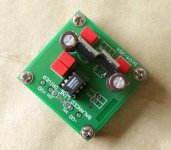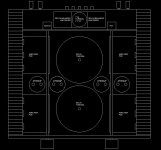I am new at this (picking quality components) can someone maybe put together a low teir ($100), middle tier($200), and a cost-no-object tier (within bounds ~$300-$400 for parts per monobloc). Is thier any guide on what to look for in parts? Quality brands, I have started to notice % tolerance, PSRR, and other trends that make up qulaity parts but I nheed a little more guidance... what parts are the most important or give the biggest gains in sound quality?
this is going to be my first amp build.
this is going to be my first amp build.
HaLo6 said:I am new at this (picking quality components) can someone maybe put together a low teir ($100), middle tier($200), and a cost-no-object tier (within bounds ~$300-$400 for parts per monobloc). Is thier any guide on what to look for in parts? Quality brands, I have started to notice % tolerance, PSRR, and other trends that make up qulaity parts but I nheed a little more guidance... what parts are the most important or give the biggest gains in sound quality?
this is going to be my first amp build.
I am going to offering kits maybe, depending on intrest.
balanced line driver
Do you know where to buy a complete balanced line driver kit with power supply or the pcbs?
thanks
Do you know where to buy a complete balanced line driver kit with power supply or the pcbs?
thanks
I am selling balanced line driver pcb's for $5 that use the drv134 opamp. Unfortunatly i have sold out of the PSU pcb.
Attachments
Re: what about this balanced drv?
That will do fine.
juluska said:
That will do fine.
it doesnt neccessarilty need to be offered as a kit, but recommendations for me to use for my kit.
HaLo6 said:it doesnt neccessarilty need to be offered as a kit, but recommendations for me to use for my kit.
My post edit didnt seem to work. I meant to say i would be offering kits, and with the kits will of course come a couple of diffrent BOM's.
You could also try and build a P1.7 by Nelson Pass as a balanced line driver. There are boards and BOM all over the net. This is supposed to be a very good balanced/unbalanced preamp driver and it is made with discrete components. Check Pass DIY or search this forum. They are very easy to build and have the added benefit of extra driver voltage for increased volume if needed.
I have nothing against opamps It is just that in the past they have created hum issues in my projects. Make sure all of your wires are twisted very tightly and you make a good star ground.
As I said before the BPA300 is an exceptional amp and has tremendous output.
I have to get my board order in before Rhysh runs out.
Tad
I have nothing against opamps It is just that in the past they have created hum issues in my projects. Make sure all of your wires are twisted very tightly and you make a good star ground.
As I said before the BPA300 is an exceptional amp and has tremendous output.
I have to get my board order in before Rhysh runs out.
Tad
Hi, if you wish to order some boards could you please add your name to the wiki. Link is in first post.
Cheers - R
Cheers - R
Rhysh,
On board the wiki for four pcb's. This will be my second BPA300 project. The first boards I got from Alex88 maybe a year and a half back. Thanks for running this GB. I have run two for the Leach amp and am quite aware of all the hard work.
One question I would like to ask concerning oscillation. There was a rather extensive thread sometime back about one BPA300 constuctor who had to remove the 39pf cap for oscillation reasons. Are there any little tweaks which could be implemented to help with oscillation issues.
I also recommend keeping the voltage on the rails to 30 volts or less. I learned this the hard way. There is a lot of heat in a 300 watt amp to be dissipated in only 6 small transistors. Alex makes some comments about heat on his website.
Tad
On board the wiki for four pcb's. This will be my second BPA300 project. The first boards I got from Alex88 maybe a year and a half back. Thanks for running this GB. I have run two for the Leach amp and am quite aware of all the hard work.
One question I would like to ask concerning oscillation. There was a rather extensive thread sometime back about one BPA300 constuctor who had to remove the 39pf cap for oscillation reasons. Are there any little tweaks which could be implemented to help with oscillation issues.
I also recommend keeping the voltage on the rails to 30 volts or less. I learned this the hard way. There is a lot of heat in a 300 watt amp to be dissipated in only 6 small transistors. Alex makes some comments about heat on his website.
Tad
proper transformer for BPA300
What is the proper transformer for BPA300? Shine7 uses a 2x25V sec 500VA toroidal. He uses it for the power amplifier pcbs and for the balanced line driver. Can I use better other smaller transformer to the drv?
What is the proper transformer for BPA300? Shine7 uses a 2x25V sec 500VA toroidal. He uses it for the power amplifier pcbs and for the balanced line driver. Can I use better other smaller transformer to the drv?
A 500VA can power upto 500W but will work better with <=320W of maximum output.
25Vac allows 8ohm speakers to be used. This in a BPA200 drives ~120W into 8ohms.
A 300BPA will drive the same load to the same maximum power but have an extra reserve of +50% current ability. This reserve can only help, due to the severely restricted output current of the 3886, particularly when it gets hot.
25Vac allows 8ohm speakers to be used. This in a BPA200 drives ~120W into 8ohms.
A 300BPA will drive the same load to the same maximum power but have an extra reserve of +50% current ability. This reserve can only help, due to the severely restricted output current of the 3886, particularly when it gets hot.
INTEGRATED BPA300 AMPLIFER
What about an integrated BPA300 amplifier with passive preamplifier in the same chassis.
The chassis can be this:
http://www.modushop.biz/ecommerce/cat079_l2.php?n=1
What about an integrated BPA300 amplifier with passive preamplifier in the same chassis.
The chassis can be this:
http://www.modushop.biz/ecommerce/cat079_l2.php?n=1
Attachments
that layout would require advanced wiring skills, it'd be difficult to avoid noise
and the trafos are also very close to the boards
it'd be much better to go for 2 monoblocks, or PS in a different case
and the trafos are also very close to the boards
it'd be much better to go for 2 monoblocks, or PS in a different case
Re: INTEGRATED BPA300 AMPLIFER
No No No No No No No 😉
The BPA300 is a power amp, seriously use a seperate enclosure from hifi2000 for your pre. Also, you want a gain stage before the BPA300 to really push it.
juluska said:What about an integrated BPA300 amplifier with passive preamplifier in the same chassis.
The chassis can be this:
http://www.modushop.biz/ecommerce/cat079_l2.php?n=1
No No No No No No No 😉
The BPA300 is a power amp, seriously use a seperate enclosure from hifi2000 for your pre. Also, you want a gain stage before the BPA300 to really push it.
Re: Re: INTEGRATED BPA300 AMPLIFER
The chipamps are reportedly better if the gain is around 26dB to 30dB.
A BPA has a gain that is twice (+6dB) of the single chipamp.
32 to 36dB of gain in a power amp is a lot, do not add any more.
Or look at it from the sensitivity for full power.
500mVac to 700mVac will give full power into either a single chipamp or into a BPA set.
No.rhysh said:you want a gain stage before the BPA300 to really push it.
The chipamps are reportedly better if the gain is around 26dB to 30dB.
A BPA has a gain that is twice (+6dB) of the single chipamp.
32 to 36dB of gain in a power amp is a lot, do not add any more.
Or look at it from the sensitivity for full power.
500mVac to 700mVac will give full power into either a single chipamp or into a BPA set.
Re: Re: Re: INTEGRATED BPA300 AMPLIFER
Sorry, i was thinking about driving the balanced line driver itself, not the actuall chipamp. I have found by using a bit more gain before the DRV134 i have came out with better results. Also i have found the DRV134 works better with a low input impedance, which would require the use of some kind of simple buffer.
AndrewT said:No.
The chipamps are reportedly better if the gain is around 26dB to 30dB.
A BPA has a gain that is twice (+6dB) of the single chipamp.
32 to 36dB of gain in a power amp is a lot, do not add any more.
Or look at it from the sensitivity for full power.
500mVac to 700mVac will give full power into either a single chipamp or into a BPA set.
Sorry, i was thinking about driving the balanced line driver itself, not the actuall chipamp. I have found by using a bit more gain before the DRV134 i have came out with better results. Also i have found the DRV134 works better with a low input impedance, which would require the use of some kind of simple buffer.
- Status
- Not open for further replies.
- Home
- Group Buys
- BPA300 Round 2

